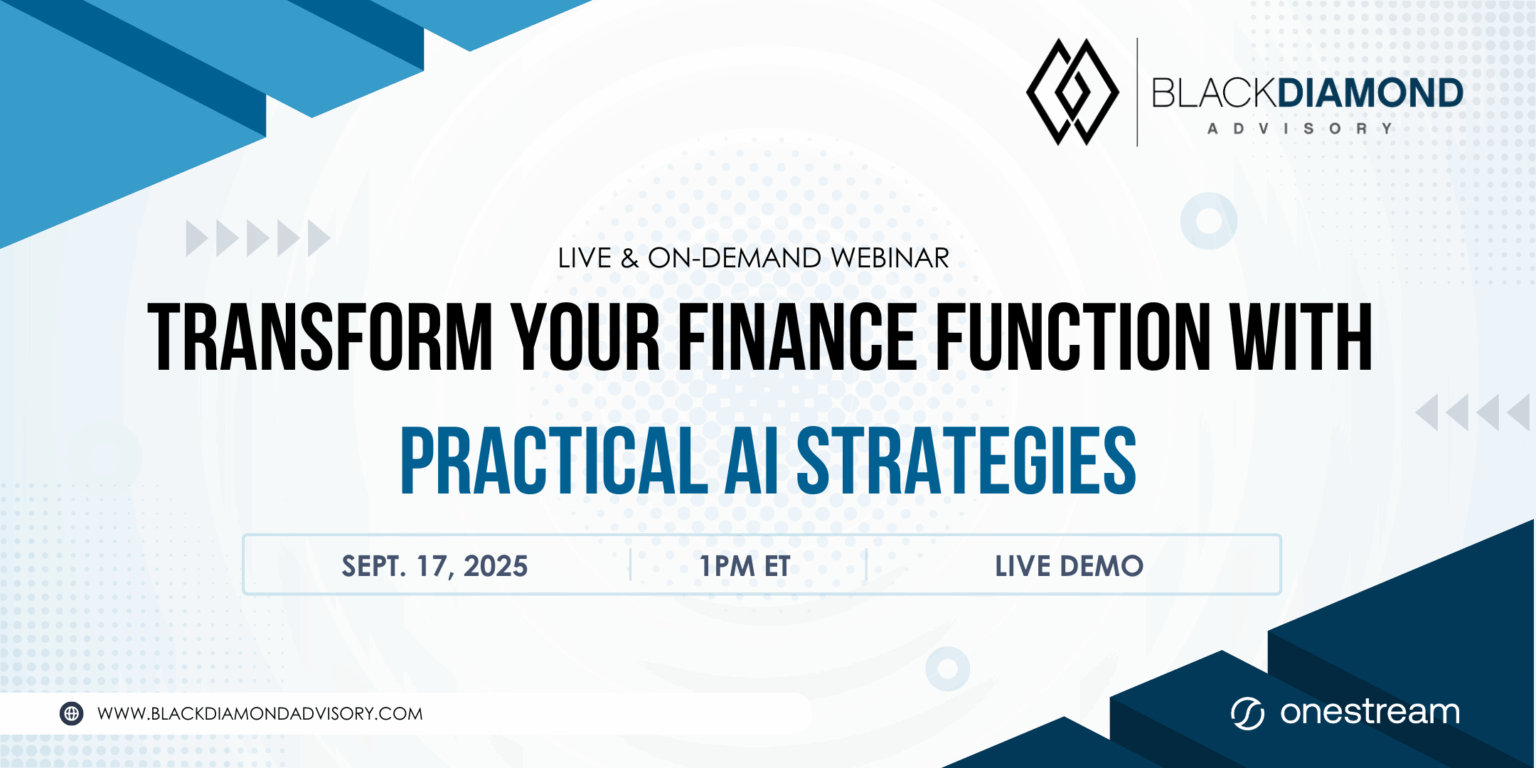All articles in this series
- OneStream Power User Talks AI
- AI Transformation in Finance
- The Future of Finance: New Operating Models for the AI Era
- Practical Implementation: Making AI Real in Finance
- Beyond Point Solutions: Why Finance Intelligence Platforms Drive Transformative Value
In the race to implement artificial intelligence, finance organizations face a critical choice: pursue incremental improvements or create truly transformative capabilities. Our research shows organizations that strategically implement all four AI value drivers achieve 25-30% higher EBITDA growth compared to those taking a piecemeal approach.
What separates high-impact AI initiatives from those delivering marginal returns? After guiding dozens of finance transformations, we’ve identified the four specific value drivers that create multiplicative impact when implemented together.
Value Driver #1: Compression of Decision Cycles
Traditional finance cycles follow a linear pattern: plan, analyze, decide, execute, measure, and adjust. This sequential approach worked in stable environments but creates dangerous lag in today’s volatile markets.
AI enables what I call “concurrent decision processing” – continuously analyzing incoming data, identifying patterns, and updating projections in real-time. The result? Organizations typically reduce forecast-to-decision cycles by 85-90%.
A consumer products company we worked with compressed their cycle from 23 days to just 3. When COVID hit, they adjusted production priorities weekly while competitors were still analyzing last month’s data.
This isn’t merely about speed – it’s about fundamentally changing how decisions flow through your organization. Military strategists call it “getting inside the opponent’s OODA loop” (Observe, Orient, Decide, Act). In business terms, it means making and executing decisions faster than market conditions change.
Value Driver #2: Reducing Bias Through Data-Driven Forecasting
Here’s an uncomfortable truth: human-generated forecasts contain systematic biases. These aren’t character flaws – they’re cognitive limitations we all share.
Consider your current process: A manager creates projections, a director reviews and adjusts, a VP applies judgment, and finally, the CFO makes tweaks. At each stage, bias enters – sometimes intentionally (sandbagging to ensure targets are met), sometimes unconsciously (overconfidence in familiar markets).
AI transforms this dynamic by establishing data-driven baselines before human judgment enters the equation. These “truth foundations” are free from recency bias, organizational politics, and emotional reactions to market conditions.
One global manufacturer discovered their forecasts consistently overestimated growth markets by 12-18% while underestimating mature market potential by 7-9%. By starting with AI-generated baselines and applying human judgment only where valuable, they improved accuracy by 42% in two quarters.
The real power isn’t replacing human judgment but enhancing it. When adjustments to AI forecasts become explicit and measurable against outcomes, you create transparency, accountability, and continuous learning.
Value Driver #3: True Convergence of Finance and Operations
Implementing AI in finance while operations uses different AI systems isn’t solving the traditional divide – it’s weaponizing it. Organizations create competing intelligence systems that make human silos look quaint by comparison.
The breakthrough happens when you build “bidirectional AI highways” where intelligence flows continuously between systems. When finance AI directly informs operations AI about budget constraints in real-time, and operations AI automatically feeds performance data back to finance, you achieve a multiplier effect that standalone systems cannot deliver.
A healthcare provider we worked with struggled with labor cost forecasting. Finance built models based on historical spending; operations built staffing models based on patient volumes. By implementing AI connecting operational metrics (patient volumes, acuity levels) to financial outcomes (labor costs, overtime), they created a unified decision framework that reduced labor cost variance by 68% while improving patient satisfaction.
This isn’t about better dashboards – it’s about creating adaptive intelligence that bridges the fundamental divide plaguing organizations for decades.
Value Driver #4: Democratizing Advanced Analytics
The final value driver addresses the most significant barrier to AI adoption: the skills gap.
Most implementations create dependency on technical specialists, making data scientists the gatekeepers to insights. The breakthrough comes when AI is embedded directly into platforms finance professionals already use, eliminating the need for specialized skills.
A retail client implemented a financial planning solution with embedded AI that allowed their FP&A team—with zero coding skills—to build predictive models incorporating weather patterns, local events, and competitive openings in days rather than weeks.
This democratization must balance with appropriate governance. As you put powerful capabilities in more hands, robust frameworks ensure sensitive data remains protected while making analytics accessible to those who understand the business context.
The Multiplicative Effect: Creating Your Decision Intelligence Engine
These value drivers don’t exist in isolation – they’re interconnected, creating exponentially greater impact together than individually.
Organizations successfully implementing all four create what I call a “decision intelligence engine” – a finance function that not only reports what happened but actively shapes what will happen through faster, better-connected decision support.
Moving Forward: Assess Your Current State
Start by honestly evaluating your organization’s capabilities:
- Decision cycle time: How long does it take from initial forecast to operational decisions? Could you respond effectively if market conditions changed dramatically next week?
- Forecast bias: Are your forecasts consistently over or under actual results in specific areas? How much manual adjustment happens in your process?
- Finance-operations connectivity: Can you articulate precisely how operational metrics impact financial outcomes? Do finance and operations speak the same language?
- Analytical democratization: How dependent is your finance team on technical specialists for advanced analytics? Could they build predictive models independently if needed?
The gaps identified will help prioritize initiatives and focus investments where they’ll create maximum value.
The transformative potential of AI in finance isn’t about technology alone – it’s about how that technology enables these four specific value drivers that fundamentally change how finance works. By implementing them as an integrated whole, you transform finance from a reporting function to a decision intelligence engine that doesn’t just keep score, but actively helps the business win the game.


